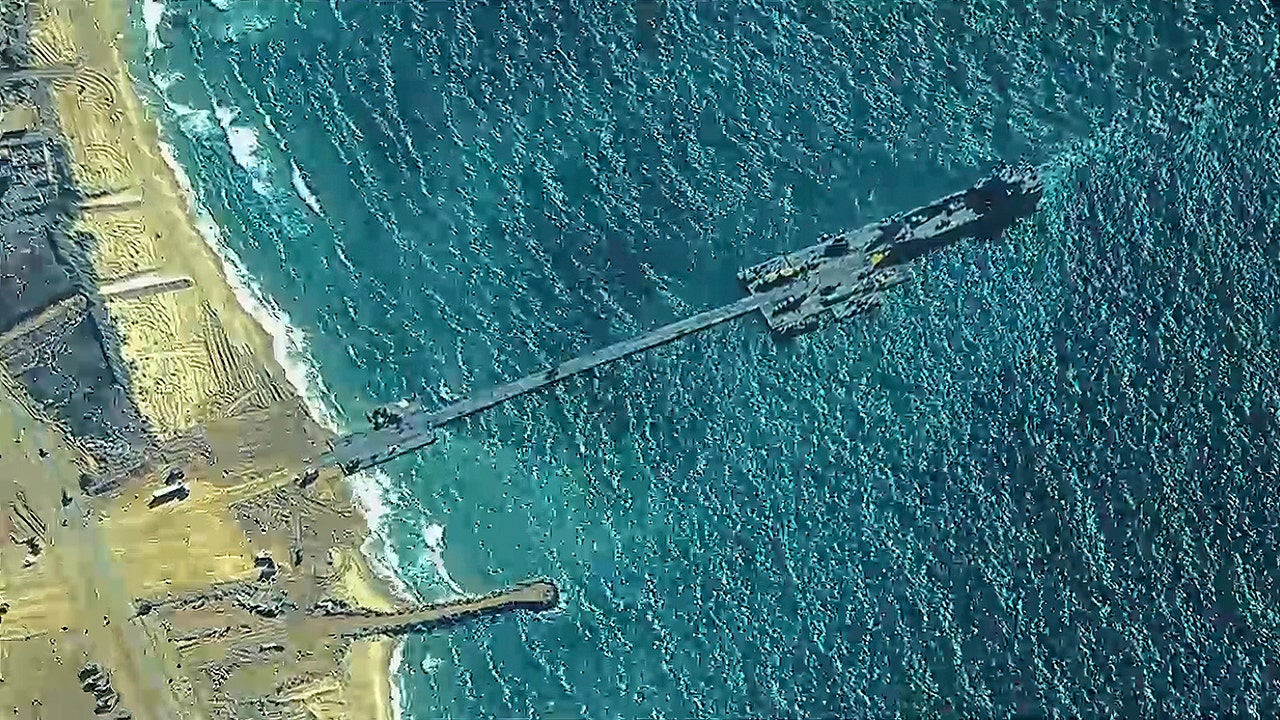World
Syria brought Wagner Group fighters to heel as mutiny unfolded in Russia
/cloudfront-us-east-2.images.arcpublishing.com/reuters/CNNFNGOLGFI2DGLIUOKPRQ3Z2M.jpg)
BEIRUT, July 7 (Reuters) – As Wagner mercenaries advanced on Moscow in an attempted mutiny in late June, authorities in Syria and Russian military commanders there took a series of swift measures against local Wagner operatives to prevent the uprising spreading, according to six sources familiar with the matter.
The previously unreported crackdown included blocking phone lines, summoning around a dozen Wagner commanders to a Russian military base, and ordering mercenary fighters to sign new contracts with the Russian defence ministry or promptly leave Syria, according to the sources, who include Syrian security officials, sources based near deployed Russian forces, and regional officials.
The sources declined to be named in order to discuss sensitive military information. Syria’s government, Russia’s defence ministry and Wagner in Russia did not respond to requests for comment.
The measures showed how Syrian authorities moved quickly to bring the mercenary force to heel, worried that their key military partner Russia was distracted by events back home, according to two Syrian sources informed of the deployments.
“Wagner’s role in Syria – as it was playing it before – is over,” said Nawar Shaban, researcher at Omran Center for Strategic Studies, an Istanbul-based independent research group focused on Syria. “Given the events, their relationship with the Syrian defence ministry is now over.”
Damascus has not publicly commented on the June 23-24 Wagner mutiny in which mercenary boss Yevgeny Prigozhin ordered his men fighting for Russia in Ukraine to march on Moscow before a deal brokered by Belarus saw them turn back and many exiled.
However, senior Syrian military and intelligence officials privately voiced concern as they watched events unfolding that the mutiny could disrupt the Russian military presence they had relied on for so long, according to a senior Syrian Republican Guard officer and a Syrian source briefed on developments.
The mercenary group’s presence in Syria is relatively small at between 250 and 450 personnel, or roughly a tenth of the estimated Russian military strength, the two Syrian sources said. There are no official figures on staffing, which vary over time.
Russia deployed its military forces and, crucially, its airpower to Syria in 2015, helping President Bashar al-Assad beat back rebels intent on toppling him.
Wagner has since been involved in combat missions and security for oil installations in Syria, with the first suspected Wagner deaths there reported as early as 2015.
For years, Moscow denied any connection with Wagner, but the group has played a very public role in Russia’s war in Ukraine. President Vladimir Putin said after the mutiny that his government funds the group.
After Prigozhin announced his uprising, a group of Russian military officers were quickly dispatched to Syria to help take charge of Wagner forces there, according to a regional military source close to Damascus and two Syrian sources with knowledge of the events, who did not provide further details.
Syria’s military intelligence cut landlines and internet links overnight on Friday June 23 from areas where Russian Wagner forces were deployed to prevent them from communicating among themselves, with Wagner in Russia, and even with relatives back home, the three sources said.
By the morning of Saturday June 24, Syrian military intelligence and Russian defence officials were coordinating closely to isolate and control Wagner operatives, according to the senior Republican Guard officer, a Syrian security source and two Syrian sources briefed on the developments.
Around a dozen Wagner officers deployed in Syria’s central province of Homs and other areas were summoned to Russia’s operational base at Hmeimim in western Latakia province, according to the Republican Guard officer and one of the Syrian sources briefed on the developments. The officer said this occurred “in the early hours of the mutiny.”
Reuters could not determine what happened to them. The Russian Reconciliation Center for Syria, headquartered in the Hmeimim base, refers all media enquiries to the defence ministry, which did not respond to requests for comment.
NEW CONTRACTS OR FLIGHTS OUT
By June 24, Wagner fighters in Syria were asked to sign new contracts by which they report directly to Russia’s defence ministry, a source with knowledge of Wagner’s deployments and two other sources with knowledge of the events said.
Their pay was also cut, those three sources said.
Those who refused the terms were flown out on Russian Ilyushin planes in the following days, two of those sources said. One said they numbered “in the dozens,” surprising Syrian officials who expected more would refuse and head into exile.
Between June 25 and 27, flight-tracking data from Flightradar24 shows at least three trips by a Russian Ilyushin plane between Latakia, Syria and Bamako, the capital of the West African nation of Mali, where Wagner also has operations. Reuters could not establish whether Wagner personnel were on board the flights.
Mali authorities did not respond to a request for comment on the flights and whether any Wagner fighters had been redeployed from Syria to Mali.
Wagner had already pulled many experienced Russian fighters out of Syria last year to fight in Ukraine following Russia’s full-scale invasion, according to Syrian analysts and a retired Syrian military officer familiar with Wagner activities.
Wagner fighters secured Syrian oilfields and Western officials say Wagner is linked to Evro Polis, a company that profits from those assets. The EU imposed sanctions on the firm in 2021.
Reuters was unable to determine the fate of those commercial interests in the wake of the Russian defence ministry’s moves against Wagner in Syria and Russia. Evro Polis did not immediately respond to emails sent to a contact address on its website.
Hmeimim base has served as a logistics hub to transit Wagner fighters on to Libya and elswhere in Africa, according to a Syrian security source and a Western diplomat based in the region. “We are watching how those Wagner operations will in turn be disrupted,” the diplomat said.
Unlike its other operations in Africa, where Wagner’s presence is larger and not subservient to the Russian military, its role in Syria’s war went little noticed at first, as Russian air power turned the tide of the conflict.
Details of its presence emerged gradually, notably in 2018 when hundreds of Wagner fighters were killed in a confrontation with U.S. forces near the Syrian city of Deir al-Zor, sources told Reuters at the time.
In the wake of the Wagner uprising, Syria’s leadership quickly restated publicly the importance of its military alliance with Russia.
Syrian first lady Asmaa al-Assad was in Russia days later to attend her son’s graduation from Moscow State University and was asked by a reporter whether she had been afraid to visit given recent events.
“Our Russian friends did not hesitate when they stood with us in our war. So we did not hesitate, and we won’t hesitate, to stand with them in their war,” she said.
Additional reporting by Laila Bassam and Tom Perry in Beirut and Ed McAllister in and Joanna Plucinska in London; Editing by Mike Collett-White and Daniel Flynn
Our Standards: The Thomson Reuters Trust Principles.

World
Israel moves in on north Gaza Hamas stronghold, pounds Rafah without advancing

World
What to know about how much the aid from a US pier project will help Gaza

A U.S.-built pier is in place to bring humanitarian aid to Gaza by sea, but no one will know if the new route will work until a steady stream of deliveries begins reaching starving Palestinians.
The trucks that will roll off the pier project installed Thursday will face intensified fighting, Hamas threats to target any foreign forces and uncertainty about whether the Israeli military will ensure that aid convoys have access and safety from attack by Israeli forces.
TEMPORARY FLOATING PIER FOR GAZA AID COMPLETED, WILL MOVE INTO POSITION ONCE WEATHER LETS UP: PENTAGON
Even if the sea route performs as hoped, U.S, U.N. and aid officials caution, it will bring in a fraction of the aid that’s needed to the embattled enclave.
Here’s a look at what’s ahead for aid arriving by sea:
WILL THE SEA ROUTE END THE CRISIS IN GAZA?
No, not even if everything with the sea route works perfectly, American and international officials say.
The image provided by U.S, Central Command, shows U.S. Army soldiers assigned to the 7th Transportation Brigade (Expeditionary), U.S. Navy sailors assigned to Amphibious Construction Battalion 1, and Israel Defense Forces placing the Trident Pier on the coast of Gaza Strip on Thursday, May 16, 2024. The temporary pier is part of the Joint Logistics Over-the-Shore capability. The U.S. military finished installing the floating pier on Thursday, with officials poised to begin ferrying badly needed humanitarian aid into the enclave besieged over seven months of intense fighting in the Israel-Hamas war. (U.S. Central Command via AP)
U.S. military officials hope to start with about 90 truckloads of aid a day through the sea route, growing quickly to about 150 trucks a day.
Samantha Power, head of the U.S. Agency for International Development, and other aid officials have consistently said Gaza needs deliveries of more than 500 truckloads a day — the prewar average — to help a population struggling without adequate food or clean water during seven months of war between Israel and Hamas.
Israel has hindered deliveries of food, fuel and other supplies through land crossings since Hamas’ deadly attack on Israel launched the conflict in October. The restrictions on border crossings and fighting have brought on a growing humanitarian catastrophe for civilians.
International experts say all 2.3 million of Gaza’s people are experiencing acute levels of food insecurity, 1.1 million of them at “catastrophic” levels. Power and U.N. World Food Program Director Cindy McCain say north Gaza is in famine.
At that stage, saving the lives of children and others most affected requires steady treatment in clinical settings, making a cease-fire critical, USAID officials say.
At full operation, international officials have said, aid from the sea route is expected to reach a half-million people. That’s just over one-fifth of the population.
WHAT ARE THE CHALLENGES FOR THE SEA ROUTE NOW?
The U.S. plan is for the U.N. to take charge of the aid once it’s brought in. The U.N. World Food Program will then turn it over to aid groups for delivery.
U.N. officials have expressed concern about preserving their neutrality despite the involvement in the sea route by the Israeli military — one of the combatants in the conflict — and say they are negotiating that.
There are still questions on how aid groups will safely operate in Gaza to distribute food to those who need it most, said Sonali Korde, assistant to the administrator for USAID’s Bureau for Humanitarian Assistance, which is helping with logistics.
U.S. and international organizations including the U.S. government’s USAID and the Oxfam, Save the Children and International Rescue Committee nonprofits say Israeli officials haven’t meaningfully improved protections of aid workers since the military’s April 1 attack that killed seven aid workers with the World Central Kitchen organization.
Talks with the Israeli military “need to get to a place where humanitarian aid workers feel safe and secure and able to operate safely. And I don’t think we’re there yet,” Korde told reporters Thursday.
Meanwhile, fighting is surging in Gaza. It isn’t threatening the new shoreline aid distribution area, Pentagon officials say, but they have made it clear that security conditions could prompt a shutdown of the maritime route, even just temporarily.
The U.S. and Israel have developed a security plan for humanitarian groups coming to a “marshaling yard” next to the pier to pick up the aid, said U.S. Vice Admiral Brad Cooper, deputy commander of the U.S. military’s Central Command. USAID Response Director Dan Dieckhaus said aid groups would follow their own security procedures in distributing the supplies.
Meanwhile, Israeli forces have moved into the border crossing in the southern city of Rafah as part of their offensive, preventing aid from moving through, including fuel.
U.N. deputy spokesman Farhan Haq said that without fuel, delivery of all aid in Gaza can’t happen.
WHAT’S NEEDED?
U.S. President Joe Biden’s administration, the U.N. and aid groups have pressed Israel to allow more aid through land crossings, saying that’s the only way to ease the suffering of Gaza’s civilians. They’ve also urged Israel’s military to actively coordinate with aid groups to stop Israeli attacks on humanitarian workers.
“Getting aid to people in need into and across Gaza cannot and should not depend on a floating dock far from where needs are most acute,” U.N. deputy spokesman Farhan Haq told reporters Thursday.
“To stave off the horrors of famine, we must use the fastest and most obvious route to reach the people of Gaza — and for that, we need access by land now,” Haq said.
U.S. officials agree that the pier is only a partial solution at best, and say they are pressing Israel for more.
WHAT DOES ISRAEL SAY?
Israel says it places no limits on the entry of humanitarian aid and blames the U.N. for delays in distributing goods entering Gaza. The U.N. says ongoing fighting, Israeli fire and chaotic security conditions have hindered delivery.
Under pressure from the U.S., Israel has in recent weeks opened a pair of crossings to deliver aid into hard-hit northern Gaza. It said a series of Hamas attacks on the main crossing, Kerem Shalom, have disrupted the flow of goods.
World
Slovakian ministers blame media and opposition for attack on PM Fico

Slovakia’s interior minister refrained from specifying the motivation behind the attack on Prime Minister Robert Fico but pointed fingers at media outlets and the opposition, urging them to reflect on how they present information.
Slovakian authorities charged a man with attempted premeditated murder on Thursday after he shot Prime Minister Robert Fico five times in the central town of Handlova.
The assault left the longstanding leader in a serious but stable condition.
“The attempt on Fico’s life was politically motivated,” Slovakia’s Interior Minister Matuš Šutaj-Eštok said during a news conference on Fico’s shooting.
Eštok said the suspect, believed to be 71, was a “lone wolf” and did not belong to any political party but had previously taken part in anti-government protests.
The minister did not specify what the motivation was, but blamed media outlets and the opposition.
“It was information that you have recently presented. The way you presented them, on that I think each of you can reflect,” he said.
Slovakia’s President-elect Peter Pellegrini said he had only been allowed to speak with Fico for a few minutes “because his current condition really requires peace and quiet without any other external distractions.”
Pellegrini wished Fico “a great deal of strength in the struggle ahead of him because he is facing a very difficult period indeed.”
The president-elect called on political parties to suspend or scale back their campaigns for European elections, which will be held June 6-9.
The populist leader had been attending a political event in Handlova when the shooting took place, sending shockwaves through the central European country.
Fico has long been a divisive figure in Slovakia and beyond. His return to power last year on a pro-Russian, anti-American message led to even greater worries among fellow European Union and NATO members that he would abandon his country’s pro-Western course – particularly on Ukraine.
At the start of Russia’s invasion, Slovakia was one of Ukraine’s staunchest supporters. Fico halted arms deliveries to Ukraine when he returned to power, his fourth time serving as prime minister.
-

 Politics1 week ago
Politics1 week ago'You need to stop': Gov. Noem lashes out during heated interview over book anecdote about killing dog
-

 News1 week ago
News1 week agoMan, 75, confesses to killing wife in hospital because he couldn’t afford her care, court documents say
-

 Politics1 week ago
Politics1 week agoRFK Jr said a worm ate part of his brain and died in his head
-

 World1 week ago
World1 week agoPentagon chief confirms US pause on weapons shipment to Israel
-

 Politics1 week ago
Politics1 week agoHere's what GOP rebels want from Johnson amid threats to oust him from speakership
-

 World1 week ago
World1 week agoPro-Palestine protests: How some universities reached deals with students
-

 World1 week ago
World1 week agoConvicted MEP's expense claims must be published: EU court
-

 Politics1 week ago
Politics1 week agoCalifornia Gov Gavin Newsom roasted over video promoting state's ‘record’ tourism: ‘Smoke and mirrors’



















